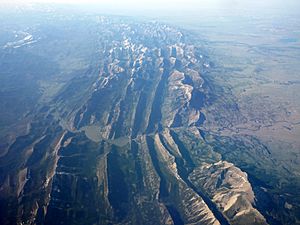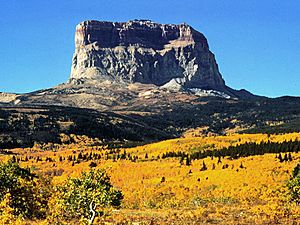Rocky Mountain Front facts for kids
The Rocky Mountain Front is a special natural area in North America. It is where the eastern slopes of the Rocky Mountains meet the flat plains. In 1983, a government group called the Bureau of Land Management said the Rocky Mountain Front was "nationally significant." This means it is very important for its wildlife, fun activities, and beautiful views. Experts have also called it a top priority for protection. This is because it has not been changed much by buildings and has "unparalleled" (meaning amazing) numbers of wild animals.
Contents
What is the Rocky Mountain Front?
The Rocky Mountain Front is clearly different from both the plains and the mountains. However, in some places like Wyoming, Montana, and New Mexico, it can be harder to see where it begins or ends. One way to describe it is a "transition zone." This is an area where the Rocky Mountains slowly change into the mixed grass prairie. It includes many different types of places, like wetlands, riverbanks, grasslands, and forests. Some people estimate that there are over 2,000,000 acres (8,100 km2) of Rocky Mountain Front land in Montana and Canada.
This area is also very important for the weather in North America. Warm air from the Gulf of Mexico gets blocked by the Front. This blocking causes strong weather like hail, thunderstorms, and tornadoes. These storms then move east. "Tornado Alley", where tornadoes happen most often, is a direct result of how the Front affects the weather.
Parts of the Rocky Mountain Front
The Rocky Mountain Front in Canada
In Alberta, Canada, the Rocky Mountain Front is about 12 to 19 miles (19 to 31 km) wide.
People knew as early as 1935 that there was a lot of coal under the Rocky Mountain Front in Alberta. By 2013, about 60 percent of all Canadian coal was thought to be in this area. Natural gas is also very common here. A company called Royal Dutch Shell started getting natural gas from the Pincher Creek Gas Field in the 1950s. They built a plant there in 1957. This field can produce a huge amount of natural gas every day. In the 1960s, Shell Oil built another plant near Waterton Lakes National Park.
Native American groups, like the Plains Indians, have lived along the Rocky Mountain Front in British Columbia and Alberta for a long time. You can find many ancient Native American rock art sites scattered throughout the area.
Building new things along the Front is somewhat limited. In the 1940s, people thought about building the Alaska Highway here. But they decided to build it closer to the coast instead. In the early 2000s, a group called the Nature Conservancy worked to protect land here. They wanted to save the homes of grizzly bears in Alberta.
The Rocky Mountain Front in Montana
The Rocky Mountain Front in Montana, from the Canadian border south to Helena, has been greatly shaped by powerful natural forces. These forces include faulting (cracks in the Earth's crust) and folding (bending of rock layers). This happened during a mountain-building event called the Sevier orogeny, between 115 and 55 million years ago. This event caused huge blocks of rock to slide over each other.
Much of this part of the Front, including the Lewis Range and Livingston Range, was heavily shaped by glaciers. The Rocky Mountain Front in this area shows some of the biggest changes in height over a short distance anywhere in North America.
Some experts say the Front in Montana is about 50 miles (80 km) wide and 200 miles (320 km) long.
Many ranches are found along the Rocky Mountain Front in Montana. The amazing scenery has also led to many guest ranches. These are places where visitors can stay and experience ranch life. Some of the most famous guest ranches are near Choteau and Augusta.
The Rocky Mountain Front in Montana has some of the last untouched native grasslands in the northern Great Plains. This area is also part of what is called the "Crown of the Continent Ecosystem." It is a great home for many wild animals. These include the black bear, cougar, deer, elk, grizzly bear, lynx, moose, wolf, and wolverine. It is one of the few places where grizzly bears still live on the prairie. Many prairie rattlesnakes are also found here.
Companies started looking for coal, oil, and natural gas along the Rocky Mountain Front in Montana in the 1970s. By the early 2000s, people thought there might be a huge amount of natural gas under the Front in Montana. Much of this land is owned by the U.S. federal government. It is managed by the United States Forest Service and the Bureau of Land Management (BLM). To protect the area, searching for oil and gas was stopped on Forest Service land for six years starting in 2001. However, in 2002, the BLM made new rules that made it easier to get oil and gas. Groups that want to protect nature have worked hard to stop energy exploration in this region.
The Rocky Mountain Front in Wyoming

Southwest Wyoming, where the borders of Idaho, Utah, and Wyoming meet, is another area where the Earth's crust has been greatly pushed and folded. This is similar to northwest Montana.
People believe the Rocky Mountain Front in Wyoming has large amounts of oil and natural gas. In the late 1970s, the U.S. Forest Service and BLM tried to open these lands for energy exploration. This led to many legal battles and changes in how federal land is used.
The Rocky Mountain Front in Colorado
In Colorado, the Rocky Mountain Front goes from the border with Wyoming south to the city of Pueblo and the Arkansas River. Famous mountains like Pikes Peak, Mount Evans, and Longs Peak are part of the Front here. Just east of the Rocky Mountain Front is the Colorado Piedmont. This area is the most developed part of the United States between Chicago and the West Coast. The only way to cross the Rocky Mountains in this area is through the Tennessee Pass.
The Rocky Mountain Front also marks the eastern edge of an area with volcanic activity in western Colorado. Several layers of sandstone are also found under the Colorado Rocky Mountain Front. These layers slope steeply down to the east.
The Rocky Mountain Front in Books
"The Rocky Mountain Front" is the name of an essay by a well-known Montana writer named A. B. Guthrie, Jr.. It was first printed in a magazine called Montana, The Magazine of Western History in 1987.



